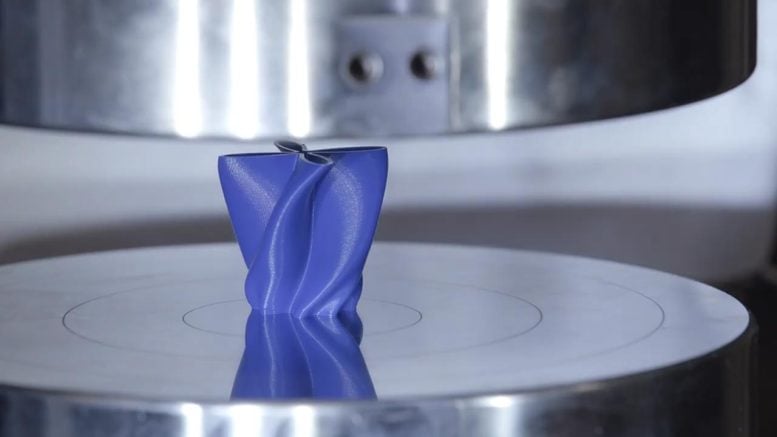
Boston University’s robot MAMA BEAR autonomously creates and tests energy-absorbing structures, recently achieving a record 75% efficiency, with applications ranging from shipping materials to military gear. Credit: Devin Hahn, Boston University Productions
An autonomous robot created a shock-absorbing shape no human ever could. Learn what it means for designing safer helmets, packaging, car bumpers, and more.
Within the confines of a lab in Boston University’s College of Engineering, a robot arm drops small, plastic objects into a box precisely placed on the floor to catch them as they fall. One by one, these tiny object—feather-light, cylindrical pieces, no bigger than an inch tall—fill the box. Some are blue, others red, purple, green, or black.
Each of these structures is the result of an experiment in robot autonomy. Operating independently and adapting through ongoing learning, the robot is on a quest to create the most efficient energy-absorbing shape to ever exist.
The Process of Innovation
To do this, the robot creates a small plastic structure with a 3D printer, records its shape and size, moves it to a flat metal surface—and then crushes it with a pressure equivalent to an adult Arabian horse standing on a quarter. The robot then measures how much energy the structure absorbed, how its shape changed after being squashed, and records every detail in a vast database.
Then, it drops the crushed object into the box and wipes the metal plate clean, ready to print and test the next piece. It will be ever-so-slightly different from its predecessor, its design and dimensions tweaked by the robot’s computer algorithm based on all past experiments—the basis of what’s called Bayesian optimization. Experiment after experiment, the 3D structures get better at absorbing the impact of getting crushed.
Inside a lab in Boston University’s College of Engineering, a robot arm drops small, plastic objects into a box placed perfectly on the floor to catch them as they fall. One by one, these tiny structures—feather-light, cylindrical pieces, no bigger than an inch tall—fill the box. Some are red, others blue, purple, green, or black. Each object is the result of an experiment in robot autonomy. On its own, learning as it goes, the robot is searching for, and trying to make, an object with the most efficient energy-absorbing shape to ever exist. Credit: Devin Hahn, Boston University Productions
Continuous Improvement and Applications
These relentless iterations are possible because of the work of Keith Brown, an ENG associate professor of mechanical engineering, and his team in the KABlab. The robot, named MAMA BEAR—short for its lengthy full title, Mechanics of Additively Manufactured Architectures Bayesian Experimental Autonomous Researcher—has evolved since it was first conceptualized by Brown and his lab in 2018. By 2021, the lab had set the machine on its quest to make a shape that absorbs the most energy, a property known as its mechanical energy absorption efficiency. This current iteration has run continuously for over three years, filling dozens of boxes with more than 25,000 3D-printed structures.
Practical Implications and Achievements
Why so many shapes? There are countless uses for something that can efficiently absorb energy—say, cushioning for delicate electronics being shipped across the world or for knee pads and wrist guards for athletes. “You could draw from this library of data to make better bumpers in a car, or packaging equipment, for example,” Brown says.
To work ideally, the structures have to strike the perfect balance: they can’t be so strong that they cause damage to whatever they’re supposed to protect, but should be strong enough to absorb impact. Before MAMA BEAR, the best structure anyone ever observed was about 71 percent efficient at absorbing energy, says Brown. But on a chilly January afternoon in 2023, Brown’s lab watched their robot hit 75 percent efficiency, breaking the known record. The results were just published today (May 21) in the journal SciTechDaily